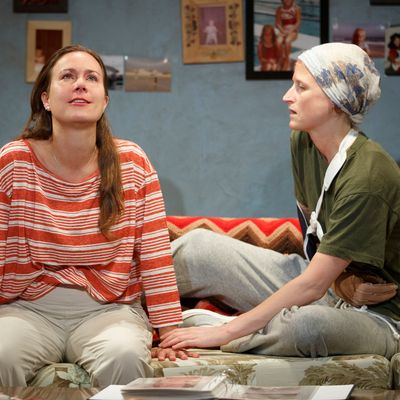
As long as there have been wars, there have been dramatic stories about returning soldiers, wounded in body or spirit. From The Odyssey to Quiara Alegría Hudes’s Elliot trilogy, with The Best Years of Our Lives and The Men and Coming Home and Arthur Laurents’s Home of the Brave in between, writers have sought to ennoble the efforts (and borrow the dramatic ironies) of veterans unable to rejoin the community they fought to defend.
As each hero’s experience of war is different, so each new war seems to evolve its own metaphor for that failed reentry, from interfering gods to alcohol to drugs to PTSD. Take Jess, the hero of Lindsey Ferrentino’s Ugly Lies the Bone, opening tonight at the Roundabout’s Black Box space beneath the Laura Pels Theatre. Jess has returned to her hometown on Florida’s “Space Coast” after three tours of duty in Afghanistan. The first two went well enough, but on the third she was severely wounded by an IED. When we meet her she has mostly been pieced back together during a 14-month hospitalization, but still limps, uses a walker, and is spotted like a leopard with third-degree burns and skin grafts that make most movement, and sometimes just standing still, torture. How she accommodates herself to her family and friends is a familiar story, unexceptionally told; the you-don’t-get-it encounters and the on-purpose-uncomfortable jokes feel recycled. (Her ex, now married, keeps referring to the source of Jess’s injury as an IUD.) But the way she adjusts to her pain, with the help of virtual-reality technology, is fresh and fascinating and periodically wondrous.
It’s also, largely, real. Ferrentino says her play was inspired by a therapeutic video game called Snow World, in which burn victims are immersed in a wintry VR landscape complete with penguins. (After the show, you can sample the game in the lobby.) The version Jess plays in her therapy sessions is lightly fictionalized; for one thing, it is customized to her preferences, although the only music choices available are patriotic songs and Paul Simon. (“Aren’t I suffering enough?” Jess tells the unseen therapist with the goddess-y voice.) The idea is that the music and the arctic landscape will overwhelm her senses, distracting her from the pain, just as the virtual cold distracts her from the lasting sensation of being burned. Jess’s game is further specialized to encourage an increasing range of motion. When she bends at the waist, her avatar acquires a shovel; when she steps a little bit forward, her avatar runs through the snow. Over the course of some unspecified number of sessions (we never quite understand how long the therapy lasts), she improves enough to realize that relieving her pain in a virtual world is not the same as relieving it in the real one.
Unfortunately, the play itself has a similar problem: Everything that happens in the social scenes is banal compared to the therapy. The doofus ex, the doting sister, and the sister’s slacker boyfriend aren’t in the same league as Jess; it’s as if Ferrentino deliberately made them and their concerns (lottery tickets, space launches, love) insufferably petty to show what Jess is up against. But Jess comes from their world, and nothing we learn about her suggests disdain for it per se. (The vivid title, drawn from an Albert Einstein couplet about beauty’s impermanence, is similarly misleading; there’s nothing morally ugly here.) The disdain can only be an unfortunate side effect — the collateral damage, if you will — of the playwright’s inability to integrate Jess into a story that’s both logical and worthy of her suffering, and also perhaps of awkward direction (by Patricia McGregor) that only exacerbates the damning contrast. The snow scenes are played in front of a curtain the width of the stage, on which projections suggest the VR world; whenever the curtain is withdrawn to reveal the sisters’ depressing home, or the gas-station convenience store where the doofus ex works, the play drops so many levels it can hardly recover.
That it keeps recovering anyway is mostly the result of the extraordinary performance of Mamie Gummer as Jess. Mimicking a moment of pain onstage involves certain tricks an actor can learn; inhabiting an existence that is nothing but pain is something I’m not sure I’ve ever seen anyone do so thoroughly. How do you make your legs twitch — for 70 minutes? How do you recoil from the air, self-strangulate your voice? Gummer’s excellence, though, amounts to an additional imbalance in the production, not because the four other actors aren’t fine but because their parts don’t call for much. You could cast them with Bette Davis and Robert Duvall and not squeeze anything else out of them. This problem — the failure of two unrelated tonalities to knit together — is serious and common, but a young dramatist can’t grapple with it unless she sees it onstage. That’s one reason the Roundabout’s Black Box series, which offers early career playwrights relatively long runs (and adventurous theatergoers extremely cheap seats), remains, at the beginning of its ninth season, so valuable. It gives writers like Ferrentino the opportunity to see the best (and worst) in what they’ve done and, with any luck, move forward to perfect their own virtual realities.
Ugly Lies the Bone is at the Roundabout Black Box Theatre through December 6.




